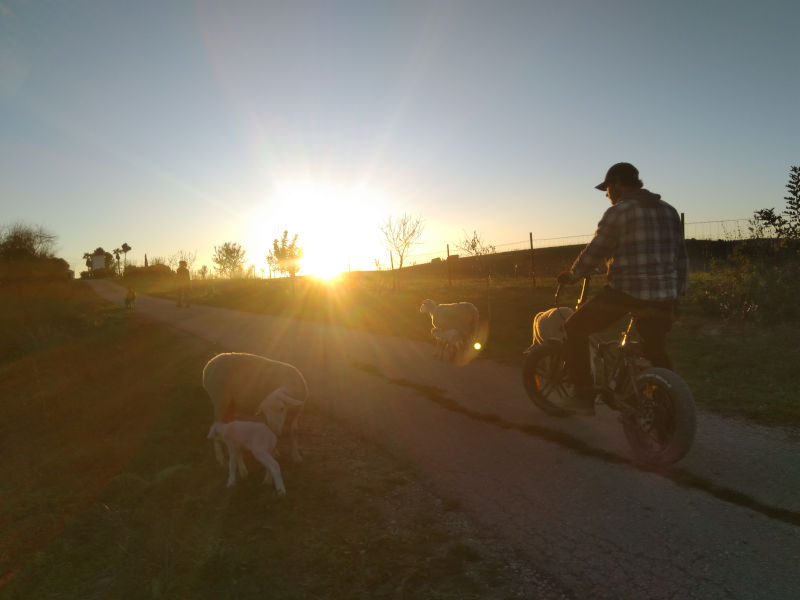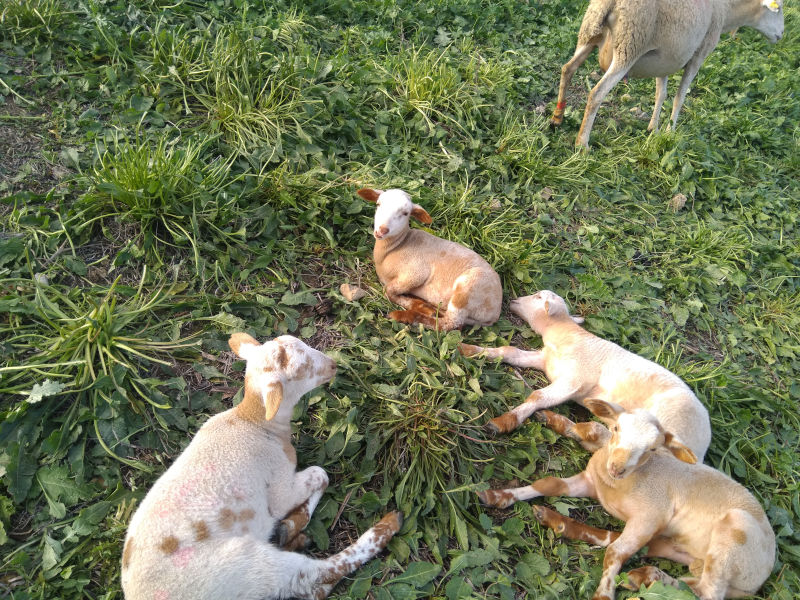Блог запис од Anna Zuurmond

A day in the life of a family-run organic regenerative livestock farm in Morón de la Frontera, Andalusia.
We wake up with the sunrise just creeping over the mountains. I scoff some porridge and a coffee, am kindly bundled into my fellow Woofer’s spare lumberjack shirt, and then we’re off. We drive to the other side of the farm, around 10 minutes, passing undulating pasture and shrubland, before dipping down into olive, almond, and carob trees. We pull up to the field of ‘expecting mothers’, where I am introduced to more of the lovely farm fam and the Spanish word for lamb: ‘Borrego’. It’s December, and we are in the middle of the first lambing season (the second follows in January). There are 7 new this morning, born in the night. Some are still slightly wet with amniotic fluid- but already wobbling around the grassy natal ward.
We are tasked with moving the newly lambs and their mothers to the other field to join the others. Easier said than done. You lift a mother’s lamb born to gently chide it away from the herd. The mum first follows, then falters, runs back to the herd and then follows again as you watch this utterly unfathomable inner struggle of ‘herd…baby…herd….baby’ unfold. Eventually, all are all in the dirt track, and we cajole them along slowly, allowing them to graze, feed and lick their lambs clean as they go. (A mother will lick its lamb’s bottom to stimulate its first poo!). On arrival, the twins go in a separate field, as they are monitored more closely; it’s not entirely uncommon that a mother can’t feed both, or neglects one. And of those, our job is to feed those neglected, skinny, or unwell. And so, a game of ‘Whose got the biggest udders?’ ensues. A handful of mothers with bazoongas are pulled aside to feed the weaker lambs. I learn that you will simply not beat a sheep 1-1; they’re faster, nimbler, and will laugh in your face. On later days, when that milk wasn’t enough or it could potentially endanger their own supply, we would go to the goats for an extra top up.
Next up, it’s time to rotate. Now, something I well and truly underestimated about farming was the amount of fencing involved. And this is certainly the case with the mode of El Sierro’s regenerative livestock farming, where the sheep are moved constantly. I have only ever learnt about ‘rotational grazing’ in theory, but what it actually means in practise is a series of movable, electric fences, which are laid, collected, re-laid, recollected, moving the sheep from one pasture to the next usually 2-3 times a day. The aim of this high-density short-interval rotation, as they explained they to me, is to use the animals to move the soil. This, they described, can improve biodiversity and soil quality, which in turn improves water infiltration, growth, and results in less erosion; meanwhile producing lambs for meat. After a pasture’s ‘sheep prune’ it’s left to rest for a long time- allowing the grass and other flora to rebound. (Pasture which I’d seen munched to within an inch of its life in December, I already saw coming back as lusciously full grassy field in January).
They have been practising this method for around 2 years. Already, they tell me, they have seen amazing results. Satellite shots show how green their farm is compared to other surrounding areas, and the water retention of their soil is so good that they can generally rely on their own water supply even in a scorching Andalusian summer. They usually rotate the sheep and lambs a few times a day, which, as you can imagine with 530 sheep situated in around 5 different herds at this point, is no small task. It is also relatively natural, organic process, but was also carefully planned by everyone at El Sierro so that the sheep and goats get a variety of vegetation in their diet- for the indulgence of a diverse dining experience, but more-so for their health and general resilience. I remember one time I moved the sheep with the owner, and before he told me which way I had to push them. We opened the fence, and they ran completely in the opposite direction into another field. I’m stressing out, running and swearing after them in Spanglish, but he calls after me ‘tranquillo- they can stay there for the morning’. He later explains to me that the sheep have their own inner intuition for food, which, when circumstances allow, there is no harm in letting them follow.
By lunchtime at the farm, my stomach was always rumbling. You’d give the neglected babies another feed, followed by a bonanza of grass, weeds, olive branches and Carob for the goats, before even thinking about human satiation. But, not to fear, because lunch was always worth the wait. Sprawled out in the sun, someone in the El Sierro fam would cook up a storm- of fresh veggies grown from garden and locally sourced meat. I don’t think I have ever eaten so well, nor as much as at El Sierro. I left a whale, but a happy and healthy one.
It took all the will in world to get going after these feasts, but the final part of the day would usually be a final moving of the herds, followed by feeding all the various animals (there were also dogs, donkeys, chickens), and then doing odd jobs. I think this was probably one of my favourite parts to the undulations of the day; the sun setting with 100 baby lambs and mardy mothers baaing noisily as they trotted over the hill to their field and bed for the night. This, followed, by walking the dog as the sky turned pink. Then it would be inside, fire on (a gorgeous wood-burning stove) and someone dishing out some fresh warm goat milk or a mint tea from the garden.

Idyllic, I know, but by no means be fooled. I think the wonderful family of El Sierro are probably some of the hardest working people I have ever met in my life. They are quite literally labouring from dusk till dawn and doing every single job, including spreading ‘a shit mixture’ (literal mixture of different animal poos) over the trees as natural deterrent to prevent the sheep eating them and waking at intervals through the night to check on the new births of lambs and goats. Their work was constant and varied, and that’s without even seeing the selling and long-term management side of things, amongst others. And something quite wonderful and worth mentioning is that the whole family is involved. The Abuelas (grandmas) live on one side of the farm, one of the sons and his wife in the middle, and their other son, his wife and their family of 5 at the other end. They run it as a cooperative: they all own the land and its corresponding animals and manage it jointly. Everyone pitches in; their kids helping when they got in from school to the older ones picking up a few weeks in the Uni Christmas holidays, right up to the eldest working there full-time. Their children live and breathe the essence and ethos of their family farm, but also bring in new ideas- from things they’ve studied to places they’ve been- new knots, new ideas on permaculture, land-management or creating an online presence.
All in all, this is a but a brief summary of an incredible time- where I learnt so much. I saw my first birth- a full head-first dive and way more goo than expected- and also my first lamb death- it happens but it’s heart-breaking. (A day at the farm was the equivalent of a month’s learning at Uni I decided- and much cheaper). My last night, in true fashion, concluded with being rudely awoken at 1am in the morning- to what at first was a little suspect baaing that I thought was coming from someone’s Netflix, but quickly became a full cacophony, followed pounding of hooves belonging of running sheep. They had escaped. I jump out of bed, put some wellies over my pyjamas and grab the other WWOOFer (who first thinks it’s the morning), then run outside with a torch. We see all these pairs of eyes staring back at us. Half an hour later and they’re back in their fence, with the electricity on this time; thank you for the send-off, guys, memorable I’ll give you that.
